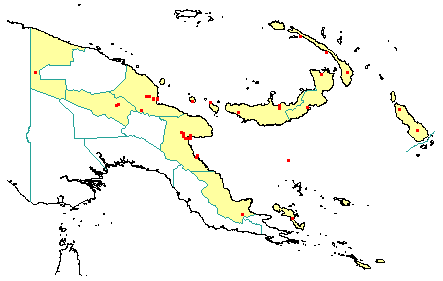
in PNGplants database
PNGTreesKey – Terminalia sepicana Diels |
Barry Conn (NSW) & Kipiro Damas (LAE).
Guide to trees of Papua New Guinea
Copyright held by the authors, National Herbarium of New South Wales, and Papua New Guinea National Herbarium
Botanische Jahrbucher für Systematik, Pflanzengeschichte und Pflanzengeographie Vol. 57: 429 (1922)
Other Literature: M.J.E. Coode, Handbooks of the Flora of Papua New Guinea 102 (1978) Fig. 21-47.
Family: Combretaceae
Dicotyledon
Timber Group: Major exportable hardwood
Field Characters: Emergent tree or Large canopy tree (20-40 m high); Bole cylindrical (up to c. 60 cm diam.); straight (bole up to 20 m long); buttresses often buttresses present or buttresses absent; spines spines absent; aerial roots aerial roots absent; stilt roots stilt roots absent; Bark grey, rough, scaly or flaky or fissured; Subrhytidome (under-bark) green or red (pinkish-green); less than 25 mm thick, 5.0-6.0; bark blaze consisting of one layer; faintly to non-aromatic; outer blaze white (straw-coloured), pale pink, or pale brown, speckled (pales), fibrous; inner blaze white (straw-coloured), pale pink, or pale brown, pale speckled, fibrous; bark exudate (sap) present, colourless, not readily flowing (spotty), colour not changing on exposure to air, not sticky; terminal buds not enclosed by leaves.
Indumentum: Complex hairs absent; stinging hairs absent; mature twig indumentum (hairs) absent.
Leaves: Leaves slightly clustered at end of branches, spiral (leaves occurring singly at a node and arranged spirally up the branchlet), simple (a leaf composed of a single blade); petiole present (c. 10 mm long), not winged, attached to base of leaf blade, not swollen; leaves broadest above middle, 8.5-15.0 cm, 4.0-8.0 cm; symmetric, entire, not dissected or lobed, obtuse or sub acute, venation pinnate, secondary veins open, prominent, intramarginal veins absent; leaves lower surface green or pale yellow, upper surface green or pale yellow, indumentum (hairs) absent when mature or present when immature, indumentum (hairs) dense to sparse; absent; domatia present, scattered along midrib (small in axils of veins of lower surface); stipules absent.
Flowers: Inflorescence axillary, flowers on an unbranched axis, cones absent; flowers unisexual and bisexual, unisexual with male and female flowers on the same plant, not stalked and stalked (shortly), flowers with many planes of symmetry, 3.0-4.0 mm long, diameter small (up to10 mm diam.); perianth present, with all sepals and/or petals (hence tepals) similar, inner perianth green; 5, some or partly joined; stamens 10, present, free of each other, free of the perianth; ovary inferior, carpels joined (when more than one), locules 1; styles solitary, 1.
Fruits: Infrutescence arranged on unbranched axis, fruit 40.0-60.0 mm long, red, not spiny, fleshy (with two lateral wings), simple, indehiscent, drupe; seeds 1, much more than 10 mm long (ca 15 mm long), not winged, broad (as wide as long), seed 1-10 mm diam.
Distribution: West Sepik, Madang, Morobe, Western Highlands, Northern, Papuan Islands, New Britain, New Ireland & Bougainville.
 | Botanical records in PNGplants database |